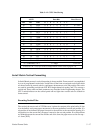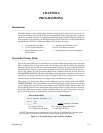
6-3Programming
Print
format, print mode, or international language selection can be controlled by a longer se
Ć
quence known as a Command Line. Command Lines are string" type commands placed beĆ
tween complete lines of text and affect the text which follows. The printer has six Command
Lines: PMODE, OSET, PSET, LPI, LINES, and INCHES. Each of these Command Lines is
discussed
in this chapter under the appropriate Control Code function.
For example, when in P-Series protocol, the form length (in inches) can be set using the folĆ
lowing
command line:
SFCC INCHES
;n.f
where
:
n" is the whole number of inches, and f" is the fractional increment in
0.5"
increments.
When using the SFCC in a Command Line, the SFCC must be the first non-blank symbol in
the line (space," hex 20, is a blank symbol). In addition, characters following spaces (other
than a valid line terminator) in a Command Line are ignored so that user comments can be
included on the Command Line. The valid line terminators are Form Feed (FF), Line Feed
(LF),
and Carriage R
eturn (CR); however, when used in the Command Line, these line termi
Ć
nators
do
not
cause any paper motion. If a Command Line contains an error, the command will
not
be executed, and the line will truncate to include any of the following error messages:
Command Line Error Messages
Error Message Explanation
INVALID PARAMETER
The command received cannot be interpreted
correctly,
or the correct command is not followed by an
expected
delimiter
.
PARAMETER OUT OF
BOUNDS
A decimal parameter in the command is out of range.
MISSING PARAMETER
ILLEGAL CHARACTER IN
One or more necessary parameters is missing
from the command.
DECIMAL PARAMETER
TOO MANY DIGITS IN
DECIMAL PARAMETER
A decimal parameter contains a non-numeric
character, or a fractional digit is out of range.
A decimal parameter contains too many digits.
Attribute Set and Reset Codes
Certain print attributes are set and reset (turned on or off) by using the appropriate ESC or
SFCC
code sequence and the numbers 1 or 0. These may be either the hexadecimal code 01 and
00, or the ASCII code for the printable symbols of decimal 1 and 0 (hexadecimal code 31 and
30, respectively). Expanded Print, Super/Subscript Print, and Underline are attributes which
are
set/reset in this fashion.


















